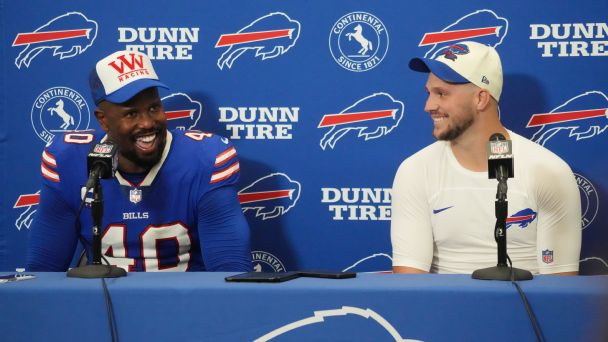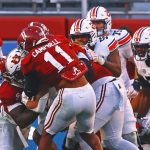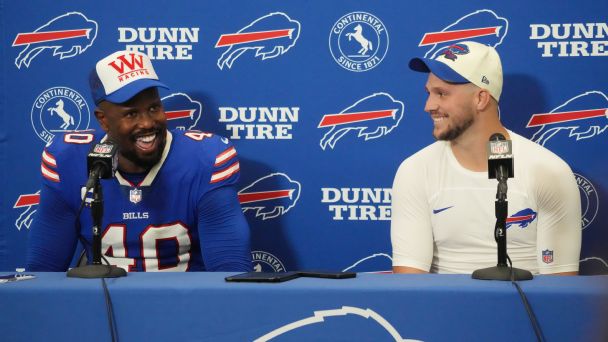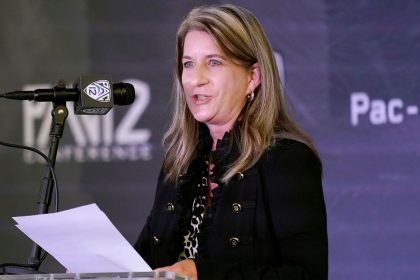
RUSSELL GAGE WAS taking out the trash at 8:30 p.m. on Monday, March 14, 2022 — two days before the official start of NFL free agency — when a random number popped up on his phone. Gage answered the call with suspicion.
“Hi, this is Tom Brady,” Gage heard on the other line.
Gage, about to hit free agency after four years as an increasingly productive wide receiver with the Atlanta Falcons, sensed a prank. But the unmistakable voice on the other end soon went into no-huddle mode, explaining in detail why he wanted Gage to become a Tampa Bay Buc.
“I was quiet for a good part of the conversation, trying to figure out what’s real,” Gage said. “He took the floor about what they had going on there, things he wanted me to be a part of, [said they had] something special going on.”
Gage told Brady he would pass along the message to his agents at Athletes First, who were well aware of Tampa’s interest.
“Wow, that was really Brady on the phone,” Gage remembers his fiancée, Kentrea, saying after Gage hung up. “I’m like, ‘right? That man just unretired not too long ago.'”
Later that week, Gage signed a three-year, $30-million contract to become Brady’s teammate with the Bucs.
Even as NFL front office executives and player agents laid the groundwork for 2023 free agency at last week’s NFL scouting combine, an unseen aspect of the imminent frenzy of player relocation was happening well behind the scenes. NFL players are permitted to recruit prospective teammates — provided those players are not under contract to another team — and talent-hungry clubs are increasingly turning to their own players to help facilitate those deals.
The financial arrangement between player and team, and the free agent’s football fit, will almost always be the most vital components of a contract agreement. The money tends to speak the loudest. But player-to-player recruitment can help inspire relocation and assuage concerns about a new home, if done correctly.
“If it’s somebody a player knows, then they will have those conversations casually anyway,” veteran NFL agent Joby Branion said. “If it’s not someone they know, it needs to be someone of prominence, like the quarterback, or it doesn’t have much of an impact.”
With the official start of NFL free agency less than a week away, ESPN spoke to those with experience in the peer-to-peer sales pitch phenomenon to detail how some of those signatures were won — or not won.
IT WAS LAST offseason that a prized Branion client, pass-rusher Von Miller, was a heavily-sought-after free agent being recruited by teams, including the Buffalo Bills, Dallas Cowboys, Cleveland Browns and the Los Angeles Rams team for which he had just won a Super Bowl.
Seeking an edge, Bills general manager Brandon Beane asked Branion if quarterback Josh Allen could call Miller, a professional courtesy that Branion considered not only a classy move but a necessary one. Miller needed to find out from a prominent player what it was really like living in Buffalo, for example.
So Branion told Miller to be on the lookout for a specific area code to signal Allen’s call, and after several missed connections while Miller was vacationing in the Bahamas, the two connected.
“Josh called me, we’re on FaceTime and he was like ‘Hey man,’ gave me the whole spiel,” Miller recounted on his podcast. “And I was like, ‘Man, this is cool.’ Everybody [else] texted me, of course my brothers from the Rams, they texted me and reached out to me, but to have somebody else from another team reach out to me…”
According to a report by The Athletic, part of the tack also included a simple but provocative text from Allen to Miller that included the names of the three quarterbacks he would be chasing in the AFC East: Zach Wilson, Tua Tagovailoa and Mac Jones.
On March 16, Miller signed a six-year, $120 million deal with Buffalo, in what was arguably the most prominent free agent signing in team history.
“When you get recruited, it feels cool to get that handwritten note, or get that FaceTime,” Miller said. “I talked to Josh Allen and [Stefon] Diggs on the phone, they both called me and it was super cool to get messages from these guys.”
“It was an interesting day,” Allen said of the interaction with Miller. “I worked my tail off. Diggs too.”
SAINTS DEFENSIVE END Cameron Jordan played the role of Cupid last month, sending a Valentine’s Day-themed tweet aimed straight for the heart of Derek Carr.
I know I said adios to social media but @derekcarrqb I know it may be too soon but it’s also Valentine’s Day are you are you trynna swap out black and silver and fall in luv with BLACK & GOLD? 😅🫶
— cameron jordan (@camjordan94) February 14, 2023
Three weeks later, when news broke of Carr’s signing with the Saints, Jordan sent a victory lap tweet while vacationing in Spain:
I get wifi and looks like we got DC4… told ya black and gold looks better @derekcarrqb
— cameron jordan (@camjordan94) March 6, 2023
Jordan calls his tweets “dry contact,” not a formal or official sales pitch but more an appreciation for the player. But he hopes it worked.
“It’s not like NFL players have actual power to tease or draft anyone,” Jordan told ESPN via text. “It’s just letting another player feel some love and admiration from their peers.”
Though tweets like this aren’t generally orchestrated by teams, sometimes front offices will utilize player resources to help attract pieces they covet. The Bills put the full-court press on Miller, for instance.
“There are many times you deal with people and they need some people to get in the game to get the team he really wants to go to,” Beane said. “And so I just wanted to make sure he really wants to come to Buffalo and he did all along.”
The communication becomes easier when an agent represents a star player on a team another client is considering. That was the case when veteran NFL agent Peter Schaffer connected Bengals running back Joe Mixon with free agent tackle La’el Collins last offseason.
Mixon’s initial message was clear, as Schaffer recalls: “C’mon, let’s get it.” Then he explained how they can win together. Collins would eventually sign a three-year, $21-million deal with Cincinnati during free agency.
“The important part of those conversations are when the player asks about the program, the team, can we win, how is the coach, the players — from two people who will be honest with each other,” Schaffer said. “He got La’el excited to be a Bengal — and if the Bengals hadn’t made significant progress as an organization, he wouldn’t have sold that.”
ODELL BECKHAM JR. is back on the free agent clock. It was last season that Beckham went on a much-publicized, weekslong “recruiting tour,” with would-be suitors, including the Cowboys, New York Giants and Bills, all publicly courting the two-time All-Pro wideout and Super Bowl winner.
Beckham and the Cowboys were linked for weeks, with Dallas’ top players making the biggest social media show of trying to attract OBJ to Big D.
“Man obj talk to me !!” Micah Parsons tweeted on Nov. 8. “Let’s do this s—!!!”
Cowboys quarterback Dak Prescott made his pitch through more conventional media means, saying of Beckham, “He knows how much I want him here.”
For their part, the Giants downplayed the need to use players to recruit the ex-New York star in this way, with Beckham’s former Giants teammate Saquon Barkley citing the existing relationship between the stars.
“I don’t have to tweet at him,” Barkley quipped.
As for the Bills, Beckham’s ex-Rams teammate Miller made it known he’d reached out to try to elicit the wideout’s services as well.
“I want him on my team,” Miller told “The Pat McAfee Show.” “And of course, I’m doing everything in my ability to make him feel comfortable with the Buffalo Bills.”
Beckham ultimately did not ink a deal as he continued his recovery from ACL surgery, but he figures to be one of the prominent names to come off the board once the 2023 free agency period begins in earnest next week. Will any of those fall 2022 sales pitches make an impact?
“What’s crazy is teams went through all that knowing Odell likely wasn’t going to play [in 2022],” an AFC executive said. “But now the groundwork is laid where when he makes a decision, it’s easy.”
1:49
How will the Jets-Rodgers meeting influence Rodgers’ decision?
Adam Schefter explains how the Jets have the best chance of landing Aaron Rodgers, but there are still many variables that must be sorted out.
THE DIRECT MESSAGE Stephon Gilmore received just before the 2021 trade deadline highlights a reality of player recruitment: Whatever the rules, there’s still plenty of gray area.
Gilmore, who hadn’t played in 2021 after failing to negotiate a contract extension with the Patriots (he was technically on the PUP list with a quad injury), received a note from Kansas City Chiefs quarterback Patrick Mahomes, who had a clear message: I want you to be a teammate.
“You see it and you’re like, ‘what’?” Gilmore said.
Gilmore knew he was being shopped ahead of a likely release by the New England Patriots, but hadn’t expected to hear from the Chiefs star.
“Mahomes gave me his number and we talked — the message was me coming here is a great situation for me,” Gilmore said. “It’s always good to have those relationships around the league where you can talk ball or other things.”
The Carolina Panthers ended up meeting New England’s trade demands, trading a sixth-round pick for the rights to Gilmore. But if Mahomes’ message was any indication, the Chiefs had heavy interest, and Gilmore sensed that.
One league executive told ESPN that, upon learning that a player in a different case was recruiting one of his players on behalf of a mutual agent to facilitate a trade, he threatened to report that team to the league in case they were involved.
But the way Gilmore sees it, conversations about players’ futures happen organically and are unavoidable. And Mahomes wasn’t the only quarterback to contact him.
“Right before the trade [to Carolina], Aaron Rodgers hit me up. Pat Mahomes hit me up,” Gilmore said. “A lot of guys [were] because it was midseason and those guys are getting ready to go to the postseason. Some guys you don’t follow, like who’s hitting me up? And then you’re like, ‘wow, I should follow them.’ It was a fun moment.
THE SINCE-RETIRED J.J. Watt knows how to access his Instagram direct messages now. This was not always the case, and Watt found out the hard way.
About a year after Watt signed a two-year, $31 million deal with the Cardinals in March 2021, Watt was playing around on his phone and for the first time sorted his DMs from top followers, filtering out the thousands of messages the star pass-rusher had from fans, well-wishers and others. What he found was about 100 missed messages from players around the league attempting to recruit him.
“I didn’t even realize there were stars from other teams in my DMs,” Watt said. “I had messages from last year saying, ‘come play here, come play here, come play here,'” Watt said. “I’m like, oh s—, I bet they are pissed.’ I wasn’t ignoring anybody. I don’t know how to properly operate the Instagram.
“I didn’t respond. I can’t say, ‘Sorry, man, I just saw this.’ I can’t respond. I’ll say hi to them in person and apologize.”
The Cardinals’ sales pitch to Watt used not players but celebrities to help land Watt, enlisting country star Blake Shelton and comedian Frank Caliendo to reach out.
“Everybody from the outside, media or fans, they have in their head what teams are involved or what contracts are in play or what you’re thinking,” Watt said. “It’s not always the teams people think.”











